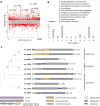Streptomyces venezuelae uses secreted chitinases and a designated ABC transporter to support the competitive saprophytic catabolism of chitin
- PMID: 40768559
- PMCID: PMC12370203
- DOI: 10.1371/journal.pbio.3003292
Streptomyces venezuelae uses secreted chitinases and a designated ABC transporter to support the competitive saprophytic catabolism of chitin
Abstract
More than a billion tons of chitin are produced on earth each year. Chitin is rich in nitrogen and carbon, making it a valuable resource in competitive microbial ecosystems. However, almost all chitin is found in large, insoluble structures like insect and crustacean exoskeletons. For this material to enter a microorganism's primary metabolism, it must be degraded extracellularly through a saprophytic process. The extracellular nature of this process means that liberated oligomers may also become accessible to other microorganisms. How microbes navigate this challenge in terrestrial ecosystems remains largely unclear. Here, we show that Streptomyces venezuelae thrives on raw, insoluble chitin as its sole carbon and nitrogen source, outperforming glucose in metabolic activity and sporulation. This was facilitated by a chitinolytic system encompassing up to 10 chitinases and the DasABC chitobiose importer. While deleting some chitinases affected growth on chitin, others did not, implying some degree of functional redundancy. A dasBC null mutation conferred a severe growth defect suggesting that chitobiose is a key breakdown product during chitin-based metabolism in S. venezuelae. The DasABC transporter also played a crucial role in preventing the built-up of chitobiose extracellularly, thereby restricting its access to Bacillus subtilis in co-cultures. Given the global ubiquity of Streptomyces in soil, this pathway likely plays a significant role in soil ecology as well as carbon and nitrogen turnover on a global scale.
Copyright: © 2025 van der Meij et al. This is an open access article distributed under the terms of the Creative Commons Attribution License, which permits unrestricted use, distribution, and reproduction in any medium, provided the original author and source are credited.
Conflict of interest statement
I have read the journal's policy and the authors of this manuscript have the following competing interests: The authors disclose that a patent application related to chitobiose production by the dasBC deletion mutant has been planned.
Figures




References
-
- Clegg CJM, D G. Advanced biology: principles and applications. 2nd ed. John Murray. 2006.
-
- Kögel-Knabner I, Rumpel C. Advances in molecular approaches for understanding soil organic matter composition, origin, and turnover: a historical overview. Adv Agron. Elsevier. 2018. p. 1–48. doi: 10.1016/bs.agron.2018.01.003 - DOI
-
- Poirier N, Sohi SP, Gaunt JL, Mahieu N, Randall EW, Powlson DS, et al. The chemical composition of measurable soil organic matter pools. Organ Geochem. 2005;36(8):1174–89. doi: 10.1016/j.orggeochem.2005.03.005 - DOI
MeSH terms
Substances
Supplementary concepts
LinkOut - more resources
Full Text Sources

